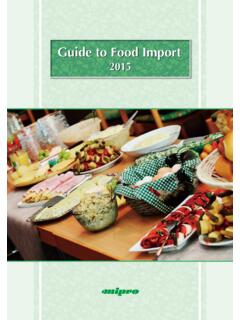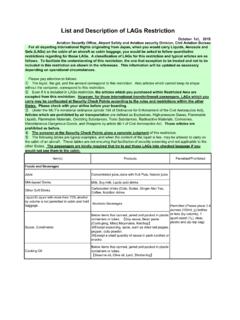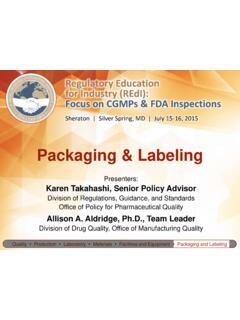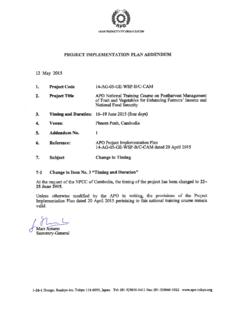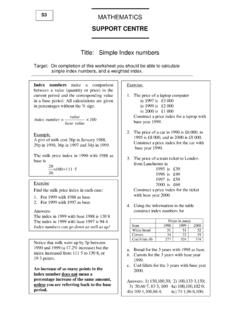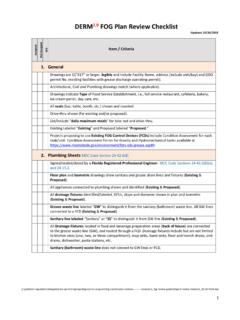Transcription of SDG Indicators under FAO Custodianship
1 SDG Indicators under FAO. Custodianship SDG Global food Loss Index December 2018 OBJECTIVES. Understand the SDG target and indicator nderstand the difference between measuring and reporting on food losses U. at country-level and at disaggregated level Clarity on definitions, concepts and boundaries How to set priorities and address the challenges ow to calculate the country food Loss Index (FLI) and Global food Loss H. Index (GFLI). How it is interpreted What goes into the index 2. GOAL 12: RESPONSIBLE. CONSUMPTION AND PRODUCTION. Target : By 2030 halve per capita global food waste at the retail and consumer level, and reduce food losses along production and supply chains including post-harvest losses . The target has been split into 2 sub- Indicators , under FAO and UN.
2 Environment Custodianship respectively food Loss By 2030, . reduce food losses along production and supply chains, including post-harvest losses.. food Waste halve per capita global food waste at the retail and consumer levels.. 3. GOAL 12: RESPONSIBLE. CONSUMPTION AND PRODUCTION. Target : By 2030 halve per capita global food waste at the retail and consumer level, and reduce food losses along production and supply chains including post-harvest losses . food Loss Index Focuses on the supply side of the market and decreasing losses in the supply chain food Loss By 2030, . reduce food losses along production and supply chains, including post-harvest losses.. food Waste Index food Waste Focuses on retail and consumer sectors and improving the halve per capita global food waste at the efficiency on the demand side retail and consumer levels.
3 Of the supply chain 4. BOUNDARIES BETWEEN THE SUB- Indicators : THE food SUPPLY CHAIN IN THE FLI. CHALLENGES THAT SDG INDICATOR. HAS ADDRESSED. A measurable definition of food Losses has been internationally agreed Guidelines on how to define and collect harvest and postharvest losses data of crops, animal and fish products have been developed and tested Complexity of measurement has been accounted addressing the multiple dimensions (stages of the value chain, typologies of actors, product characteristics, value chain length and complexity) and minimising data costs Reporting both the national and international Indicators in a comparable way is possible THE REMAINING CHALLENGE IS THAT. Reliable nationally representative data on losses are generally not available ( official data reported yearly in FAOSTAT).
4 Mainly case studies based on expert opinions focused on few products or stages of the value chain 6. MEASURED DEFINITION OF food . LOSSES. FAO definition of food Losses used for Translated into operational Agricultural Statistics and the FLI. measurement means: food losses Crop and livestock product losses Quantities cover all quantity losses along the supply chain All supply stages (Harvest-Retail). for all utilizations ( food , feed, seed, industrial, Any amount that leaves the chain for other), up to but not including the retail/ any reason consumption level. Losses of the commodity as a whole (including edible and non-edible parts) waste occurring on the supply and losses, direct or indirect, that occur during side is measured under losses . storage, transportation and processing, also of Information on the causal factors is relevant imported quantities, are therefore all collected irrespective of included.
5 Intentionality to allow for ex-post policy and analysis Non- food utilizations are NOT losses ( feed, biofuel production, etc.). Includes Edible + Inedible parts Losses are tracked by commodity starting on the production site GLOBAL & COUNTRY. food LOSS INDEX. 8. food LOSS INDEX (FLI) - MAIN. PRINCIPLES AND METHODOLOGY. 1. Focuses on 10 key commodities in 5 main groups 2. Monitors food Loss Percentages (FLP) and not on total losses 3. Monitors changes in the food Loss Percentage over time 4. Based on nationally representative loss data along the supply chain 9. food LOSS INDEX (FLI) MONITORS. LOSS PERCENTAGES BY. COMMODITY AT COUNTRY LEVEL. hy percentage losses and W 6,000,000. 5,000,000. 16. 14. not total losses? 12. Percentage 4,000,000 10. tons 3,000,000 8.
6 2,000,000 6. 4. 1,000,000. In many cases, a flat percentage 0. 2. 0. based on expert opinion is used to estimate losses over a period of time. year When applied to production quantities, Production (tons) Loss (tons) Loss (%). total losses will fluctuate proportionally to production, but in reality nothing in the system has changed. Country example. Total losses are estimated using a constant factor of 15%. Production and losses in tons fluctuate. 10. COMPILING THE food LOSS. INDEX (FLI). food Loss Percentage can be interpreted as the A. percentage of production that does not reach the retail stage. Steps to compiling the FLI, if the data exists: 1. Select Basket of commodities and compile weights 2. Compile food Loss Percentages (FLP). food Loss Index 3.
7 Compare FLP's over time 11. COMPILING THE food LOSS INDEX. (FLI) ESTIMATE THE LOSS. PERCENTAGES OF EACH. COMMODITY. Loss percentages in the FLI can be survey-based or model-based estimates. Survey-based estimates are not trivial to obtain, but FAO has developed guidelines for data collection and strategies to support countries in getting the loss estimates by commodity is the loss percentage (estimated or observed). where j = commodity, i = country, t = year 12. COMPILING THE food LOSS INDEX (FLI) COMPILE. THE LOSS PERCENTAGE FOR THE WHOLE BASKET. The food Loss Percentage (FLP) of the whole basket of commodities at country level is calculated as : weights = ( 0 0 ) / ( 0 0 ) T he FLP is a weighted average of the loss percentages of the selected 10 commodities in the basket.
8 13. COMPILING THE food LOSS INDEX (FLI) . GRAPHIC REPRESENTATION OF STEPS 1 AND 2. nationally representative loss Item 1 Harvest Farm Transport Storage Wholesale Processing percentages (lijt) by commodity Item 2. Harvest Farm Transport Storage Wholesale . Processing . Item 3 Harvest Farm Transport Storage Wholesale . Processing FLP.. Item 4 Harvest Farm Transport Storage Wholesale Processing .. Each commodity's supply chain can . = be disaggregated down to stage. Estimates for the different stages can Weighted Aggregation =0 /. of all commodities in . the ( =0 ) come from various sources and tools. country basket => FLP. 14. COMPILING THE food LOSS INDEX. (FLI) OF A COUNTRY STEP 3. Calculate the country food Loss Index = / 0 100. This is sub-indicator for SDG reporting and monitoring Where: i = country, t = year t0 is the base year (set at 2015 for the SDG monitoring) is the country food Loss Percentage T he country FLI shows the change in the food Loss Percentage over time (compared to a base period).
9 15. COMPILING THE food LOSS INDEX (FLI).. GRAPHIC REPRESENTATION OF STEP 3. ( , ) = ( . )/ ( ) 100. 2015 2016 2017 2018 2019 2020 2021. FLI = 100 FLI FLI FLI FLI FLI FLI. FLP FLP FLP FLP FLP FLP. FLP. 16. INDICATOR - GLOBAL food . LOSS INDEX (GFLI). Countries' FLI must be aggregated for SDG monitoring by regions and for the world, which will be done as part of FAO's custodial role. = =1 / =1 *100 Where: are the country weights equal to the total agricultural value of production 17. UNDERLYING DECISIONS IN THE food LOSS INDEX. 18. WHAT DATA IS NEEDED TO. INFORM RELEVANT POLICIES? Reducing losses falls into several policy objectives . Improving competiveness and value-added of agricultural producers and value chain actors;. Increasing the efficiency of supply chains through logistics, infrastructure, and equipment Addressing risks that come from changes in the climate and economic conditions.
10 All while improving the welfare of the population, particularly those in extreme poverty or with severe food shortages. which policy applies affects the data needs 19. WHAT COMMODITIES IN THE. BASKET? S etting a common basket of goods for global monitoring is a challenge: the same commodities are not relevant for all countries loss statistics cannot cover the entire food production and diet T here is a trade-off between relevance at country level and comparability across countries Comparability Relevance Ensure comparability by main product Countries determine the two commodities in category across diverse diets: each heading based on 1. Cereals . 2. Fruits And Vegetables;. Policy focus 3. Roots, Tubers & Oil-Bearing Crops;. 4. Animals products; Economic relevance 5.










